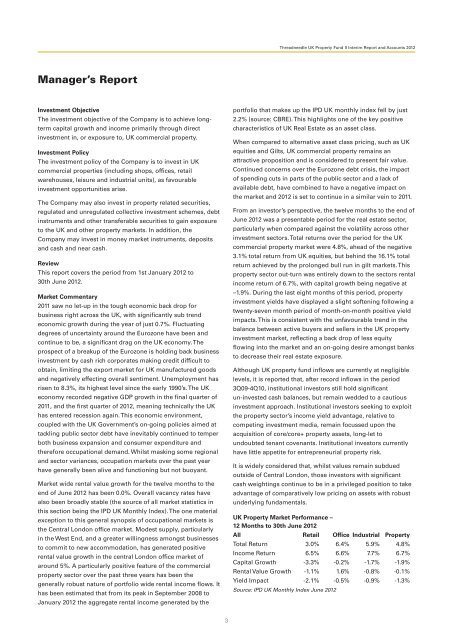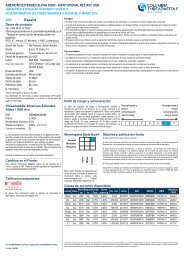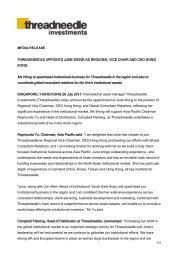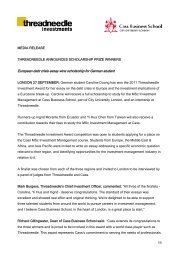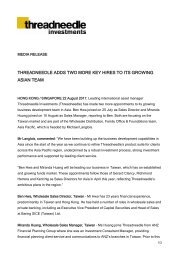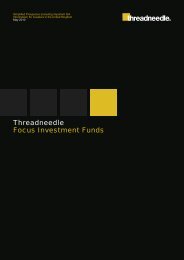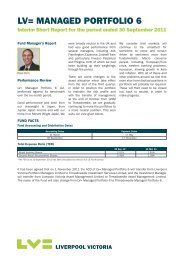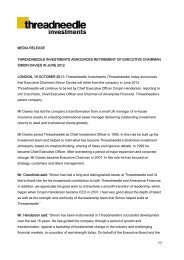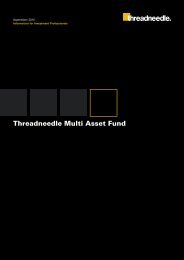Threadneedle UK Property Fund II - Threadneedle Investments
Threadneedle UK Property Fund II - Threadneedle Investments
Threadneedle UK Property Fund II - Threadneedle Investments
You also want an ePaper? Increase the reach of your titles
YUMPU automatically turns print PDFs into web optimized ePapers that Google loves.
<strong>Threadneedle</strong> <strong>UK</strong> <strong>Property</strong> <strong>Fund</strong> <strong>II</strong> Interim Report and Accounts 2012<br />
Manager’s Report<br />
Investment Objective<br />
The investment objective of the Company is to achieve longterm<br />
capital growth and income primarily through direct<br />
investment in, or exposure to, <strong>UK</strong> commercial property.<br />
Investment Policy<br />
The investment policy of the Company is to invest in <strong>UK</strong><br />
commercial properties (including shops, offices, retail<br />
warehouses, leisure and industrial units), as favourable<br />
investment opportunities arise.<br />
The Company may also invest in property related securities,<br />
regulated and unregulated collective investment schemes, debt<br />
instruments and other transferable securities to gain exposure<br />
to the <strong>UK</strong> and other property markets. In addition, the<br />
Company may invest in money market instruments, deposits<br />
and cash and near cash.<br />
Review<br />
This report covers the period from 1st January 2012 to<br />
30th June 2012.<br />
Market Commentary<br />
2011 saw no let-up in the tough economic back drop for<br />
business right across the <strong>UK</strong>, with significantly sub trend<br />
economic growth during the year of just 0.7%. Fluctuating<br />
degrees of uncertainty around the Eurozone have been and<br />
continue to be, a significant drag on the <strong>UK</strong> economy. The<br />
prospect of a breakup of the Eurozone is holding back business<br />
investment by cash rich corporates making credit difficult to<br />
obtain, limiting the export market for <strong>UK</strong> manufactured goods<br />
and negatively effecting overall sentiment. Unemployment has<br />
risen to 8.3%, its highest level since the early 1990’s. The <strong>UK</strong><br />
economy recorded negative GDP growth in the final quarter of<br />
2011, and the first quarter of 2012, meaning technically the <strong>UK</strong><br />
has entered recession again. This economic environment,<br />
coupled with the <strong>UK</strong> Government’s on-going policies aimed at<br />
tackling public sector debt have inevitably continued to temper<br />
both business expansion and consumer expenditure and<br />
therefore occupational demand. Whilst masking some regional<br />
and sector variances, occupation markets over the past year<br />
have generally been alive and functioning but not buoyant.<br />
Market wide rental value growth for the twelve months to the<br />
end of June 2012 has been 0.0%. Overall vacancy rates have<br />
also been broadly stable (the source of all market statistics in<br />
this section being the IPD <strong>UK</strong> Monthly Index). The one material<br />
exception to this general synopsis of occupational markets is<br />
the Central London office market. Modest supply, particularly<br />
in the West End, and a greater willingness amongst businesses<br />
to commit to new accommodation, has generated positive<br />
rental value growth in the central London office market of<br />
around 5%. A particularly positive feature of the commercial<br />
property sector over the past three years has been the<br />
generally robust nature of portfolio wide rental income flows. It<br />
has been estimated that from its peak in September 2008 to<br />
January 2012 the aggregate rental income generated by the<br />
portfolio that makes up the IPD <strong>UK</strong> monthly index fell by just<br />
2.2% (source: CBRE). This highlights one of the key positive<br />
characteristics of <strong>UK</strong> Real Estate as an asset class.<br />
When compared to alternative asset class pricing, such as <strong>UK</strong><br />
equities and Gilts, <strong>UK</strong> commercial property remains an<br />
attractive proposition and is considered to present fair value.<br />
Continued concerns over the Eurozone debt crisis, the impact<br />
of spending cuts in parts of the public sector and a lack of<br />
available debt, have combined to have a negative impact on<br />
the market and 2012 is set to continue in a similar vein to 2011.<br />
From an investor’s perspective, the twelve months to the end of<br />
June 2012 was a presentable period for the real estate sector,<br />
particularly when compared against the volatility across other<br />
investment sectors. Total returns over the period for the <strong>UK</strong><br />
commercial property market were 4.8%, ahead of the negative<br />
3.1% total return from <strong>UK</strong> equities, but behind the 16.1% total<br />
return achieved by the prolonged bull run in gilt markets. This<br />
property sector out-turn was entirely down to the sectors rental<br />
income return of 6.7%, with capital growth being negative at<br />
–1.9%. During the last eight months of this period, property<br />
investment yields have displayed a slight softening following a<br />
twenty-seven month period of month-on-month positive yield<br />
impacts. This is consistent with the unfavourable trend in the<br />
balance between active buyers and sellers in the <strong>UK</strong> property<br />
investment market, reflecting a back drop of less equity<br />
flowing into the market and an on-going desire amongst banks<br />
to decrease their real estate exposure.<br />
Although <strong>UK</strong> property fund inflows are currently at negligible<br />
levels, it is reported that, after record inflows in the period<br />
3Q09-4Q10, institutional investors still hold significant<br />
un-invested cash balances, but remain wedded to a cautious<br />
investment approach. Institutional investors seeking to exploit<br />
the property sector’s income yield advantage, relative to<br />
competing investment media, remain focussed upon the<br />
acquisition of core/core+ property assets, long-let to<br />
undoubted tenant covenants. Institutional investors currently<br />
have little appetite for entrepreneurial property risk.<br />
It is widely considered that, whilst values remain subdued<br />
outside of Central London, those investors with significant<br />
cash weightings continue to be in a privileged position to take<br />
advantage of comparatively low pricing on assets with robust<br />
underlying fundamentals.<br />
<strong>UK</strong> <strong>Property</strong> Market Performance –<br />
12 Months to 30th June 2012<br />
All Retail Office Industrial <strong>Property</strong><br />
Total Return 3.0% 6.4% 5.9% 4.8%<br />
Income Return 6.5% 6.6% 7.7% 6.7%<br />
Capital Growth -3.3% -0.2% -1.7% -1.9%<br />
Rental Value Growth -1.1% 1.6% -0.8% -0.1%<br />
Yield Impact -2.1% -0.5% -0.9% -1.3%<br />
Source: IPD <strong>UK</strong> Monthly Index June 2012<br />
3


